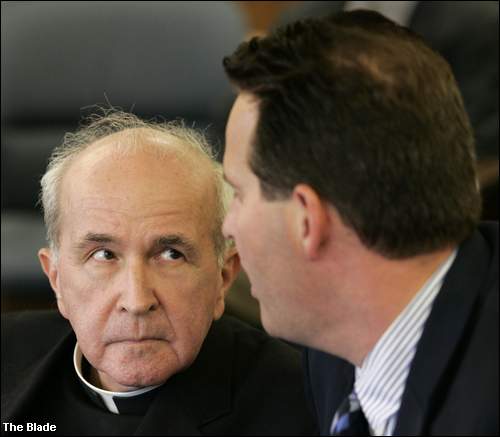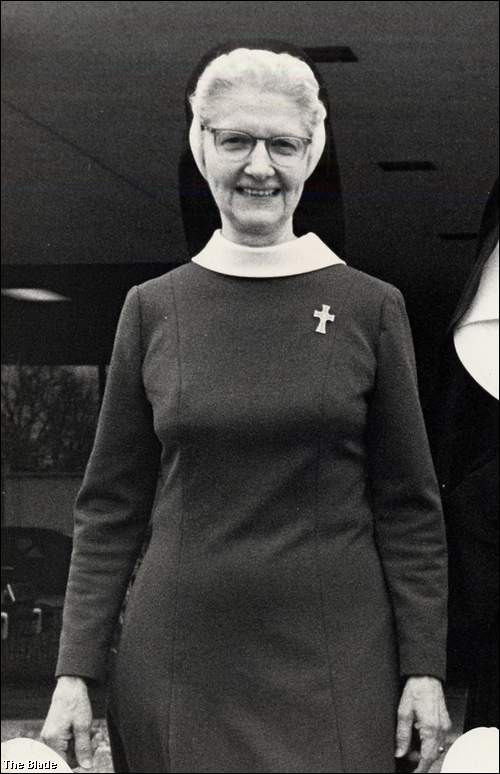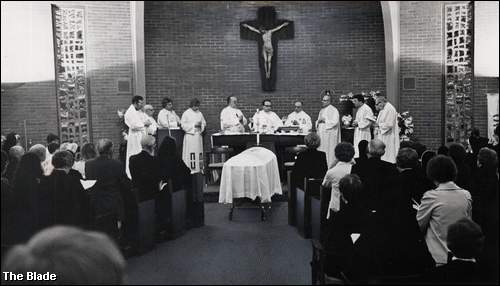By David Yonke
Toledo Blade
April 15, 2006
http://toledoblade.com/apps/pbcs.dll/article?AID=/20060415/NEWS02/60415005
It is believed to be the first time a priest has faced a murder trial for the death of a nun, and it's happening in Toledo on Monday.
On a cold April morning in 1980, the day before Easter, an elderly nun was strangled and stabbed in the room next door to Mercy Hospital's chapel.
Another nun found the body of Sister Margaret Ann Pahl on the marble floor of the sacristy, where she had gone to prepare the chapel for Holy Saturday Mass.
 |
|
The Rev. Gerald Robinson speaks with attorney John Thebes at an earlier court hearing. Photo by The Blade |
The 71-year-old nun, a member of the Sisters of Mercy of the Union, had been strangled, then stabbed between 27 and 32 times in the chest and neck. Her undergarments had been pulled down over an ankle.
The brutal killing shocked Toledo and the nation, but despite months of intensive media coverage and police work, no killer was found.
Homicide detectives eventually packed up their reports, boxed the evidence, and put everything on the shelf.
Until December, 2003.
That month, a Toledo cold-case squad, acting on new information, dusted off the evidence and reopened the investigation. On April 23, 2004, they announced that they were charging a local priest, the Rev. Gerald Robinson, in the murder of Sister Margaret Ann.
 |
| Sister Margaret |
Father Robinson pleaded innocent and posted $200,000 bond, with relatives and supporters putting their homes up as bond equity.
A number of national crime experts say they are unaware of any other U.S. trial involving a priest charged with murdering a nun.
On Monday, the long-delayed trial is scheduled to begin with jury selection in Lucas County Common Pleas Court. And however the jury rules, the priest could, in theory, face yet another trial through the Roman Catholic Church — if church officials decided to do so.
The proceedings in Judge Thomas Osowik's Common Pleas Court are going to be closely watched, not just in northwest Ohio and southeast Michigan, but throughout the country. CourtTV plans to provide gavel-to-gavel coverage and journalists from national media already are converging on Toledo.
Ray Vetter, an 82-year-old retired Toledo police deputy chief, has patiently been waiting for justice in the case that he considers the biggest disappointment of his 34-year law-enforcement career.
"If he did it, I hope they find him guilty. And if he didn't do it, I hope he's found innocent," Mr. Vetter said this week.
From the first day, he said, there was "only one suspect" in the case: Father Robinson.
"I would like to have finished it up right off the bat in 1980, but we didn't have the evidence," Mr. Vetter said. "We discussed it with the prosecutor, and he didn't think we could get a conviction. I didn't think we could get a conviction. And there's no sense going to trial if you don't think it will lead to a conviction."
He said police at that time lacked the technology that made the arrest possible today.
Bloodstains One of the technical tools that cold-case investigators Steve Forrester and Tom Ross said was pivotal for reopening the case is blood-pattern transfer analysis.
 |
|
Priests, including the Rev. Gerald Robinson, center under the crucifi x, celebrate the funeral Mass for Sister Margaret Ann Pahl. Photo by The Blade |
That forensic tool analyzes patterns imprinted in blood when a weapon is laid down.
They said a police officer noticed a unique bloodstain pattern in the altar cloth that the killer had wrapped around Sister Margaret Ann's body. Investigators said the pattern proves conclusively that a letter opener belonging to Father Robinson was at the scene of the crime and was used in Sister Margaret Ann's murder.
But John Philpin, a forensic psychologist from Vermont who has been following the case closely, said blood-transfer pattern analysis, by itself, would not be strong enough evidence to reopen a high-profile, decades-old murder case.
"I feel it would be terribly imprecise and subjective. … I would hesitate to call it an absolute science," said Mr. Philpin, who retired after 30 years of helping police departments around the nation profile murderers and analyze evidence.
"If that's the fulcrum of their prosecution, I can't see them convicting this man," he said. "I have to wonder what else they have."
Investigators added another bizarre twist to the already unique story the day after Father Robinson's arrest.
In a news conference at Toledo's Public Safety Building, Sergeant Forrester and Detective Ross said they believed Father Robinson acted alone and that a "ceremony" had taken place in the hospital's chapel. They said Sister Margaret Ann's death was part of that ceremony but did not elaborate.
The ambiguous reference to a ritual ties in with another strange element to the case — allegations by a Toledo woman that she was sexually, physically, and psychologically abused as a child by a cult that included Father Robinson and several local religious-order priests.
In the fall of 2003, the victim, now in her mid-40s, delivered a four-page typewritten letter to the Toledo diocese detailing her allegations in hopes that church officials would pay for her therapy bills.
In her testimony, she described being subjected to Satanic ceremonies in which priests placed her in a coffin filled with cockroaches, forced her to eat what she thought was a human eyeball, and penetrated her with a snake "to consecrate these orifices to Satan."
She also alleged that the group of clerics killed an infant and a 3-year-old child, performed an abortion on her, and chopped up dogs during the rituals.
The Rev. Bob Larson, an evangelist who travels the world performing exorcisms and dealing with cults, said such allegations are "very, very common. I've personally heard of such stories from hundreds of people."
Robert Cooley, a licensed psychologist who served on the Toledo diocese's review board, listened to the woman's testimony and read her statement. Despite warnings not to do so by a diocesan attorney, he took the allegations to the Ohio attorney general's office in Bowling Green.
Mr. Cooley was promptly fired from the review board over alleged "breach of confidentiality."
The attorney general forwarded the woman's allegations to the Lucas County prosecutor's office, where one of the veteran cold-case investigators who read her testimony recognized Father Robinson as being a suspect in Sister Margaret Ann's slaying.
That led to the reopening of the 1980 murder case.
John Connors, a former seminarian who retired after 25 years as a police officer, was hired by the Toledo diocese to investigate the woman's allegations.
"I think she told the truth," Mr. Connors said flatly this week. "I interviewed her, almost 20 hours' worth, and I got a pretty good feel for it."
Mr. Connors said he was preparing to interview Father Robinson in the spring of 2004 when he was taken off the case on orders of the Rev. Michael Billian, episcopal vicar of the diocese.
Shortly after, Father Robinson was arrested.
The trial is expected to last three to four weeks, and among the 40 to 50 experts scheduled to testify are Kathleen Reichs, a nationally known forensic anthropologist whose writings inspired the Fox TV show Bones, and Paulette Sutton, a Memphis medical examiner and leading authority in blood-pattern transfer analysis.
Dave Davison, a retired Toledo policeman who was the first to arrive at the murder scene in 1980, said he does not expect the trial to go to a jury.
"I think he'll do the Alford plea," said Mr. Davison. In an Alford plea, the defendant does not admit guilt but admits sufficient evidence of guilt exists to convince a judge or jury.
After retiring, Mr. Davison campaigned for the murder case to be reopened, writing letters to the police chief, the governor, the Pope, and others.
"I think Robinson will wait to see how the trial is going and if it looks like he's going to get convicted, he'll roll over to an Alford."
Whatever the outcome of the case, there is another strange twist possible — at least in theory.
TRIAL PARKING
Television satellite trucks and other media covering the murder trial of the Rev. Gerald Robinson at the Lucas County Common Pleas Courthouse will cause the loss of some onstreet meter parking around the courthouse for the next three or four weeks while the trial is under way.
Beginning Monday , there will be no public parking at meters on the east side of Michigan Street from Jackson to Adams streets and on both sides of Adams from Michigan to Erie Street. Meters will be bagged and the areas will designated parking for media vehicles until the end of the trial.
Church's legal code
Canon law, the Catholic legal code, has provisions for the church to hold trials for priests and others accused of such crimes as homicide and kidnapping, according to Richard Gaillardetz, professor of Catholic studies at the University of Toledo.
"Canon law No. 1397 lists homicide as a canonical crime," Mr. Gaillardetz said. "The church court can hold a canonical proceeding and can apply a penalty, including laicization" or returning the individual to layman status.
The Rev. Jim Auth, a Toledo priest and canon lawyer, said it's not likely to happen, however.
"Canon law preceded civil law," Father Auth said. "That's why canon law does have provisions on kidnapping and homicide and such. But to say that it is an actively used section would be wrong. It hasn't been used for a thousand years."
Contact David Yonke at: dyonke@theblade.com or 419-724-6154.
Any original material on these pages is copyright © BishopAccountability.org 2004. Reproduce freely with attribution.